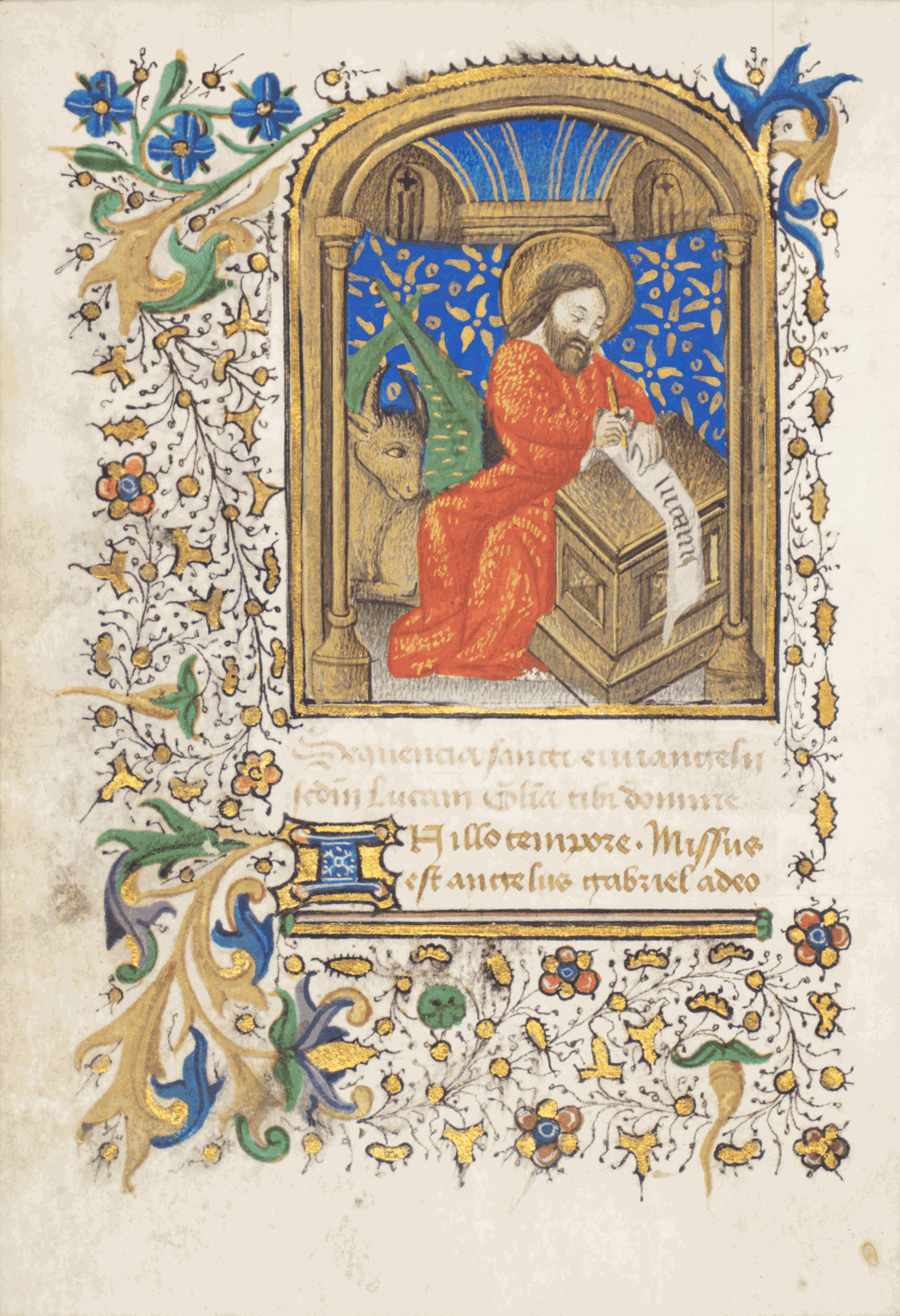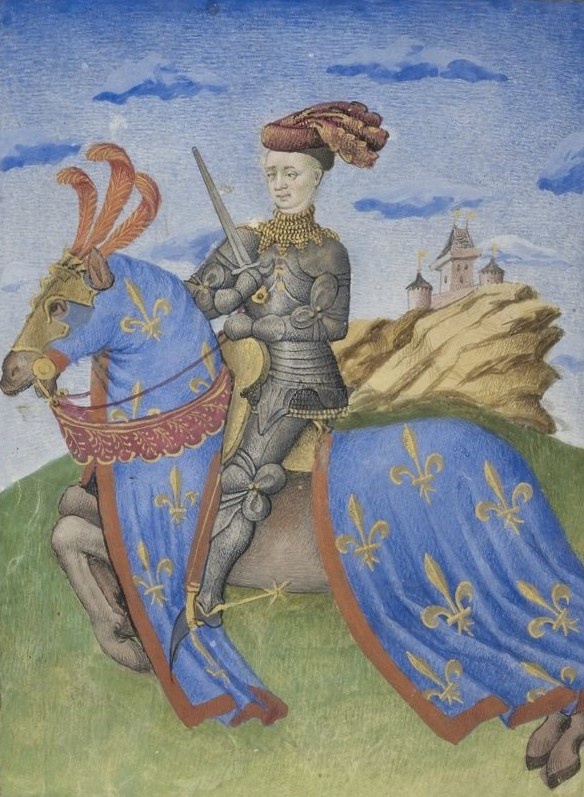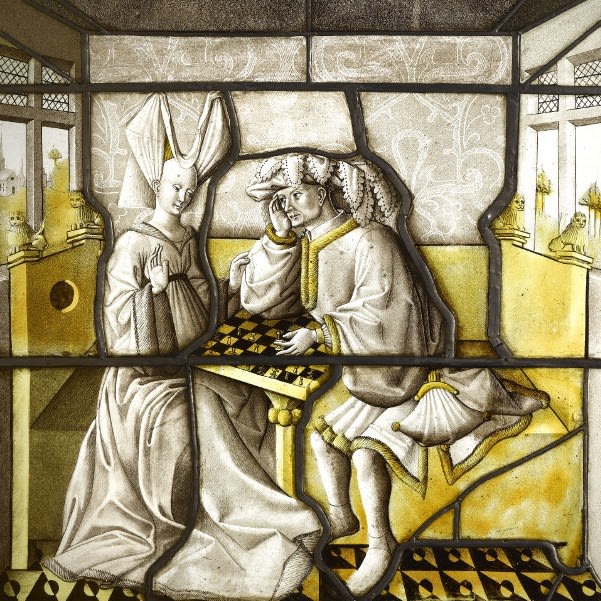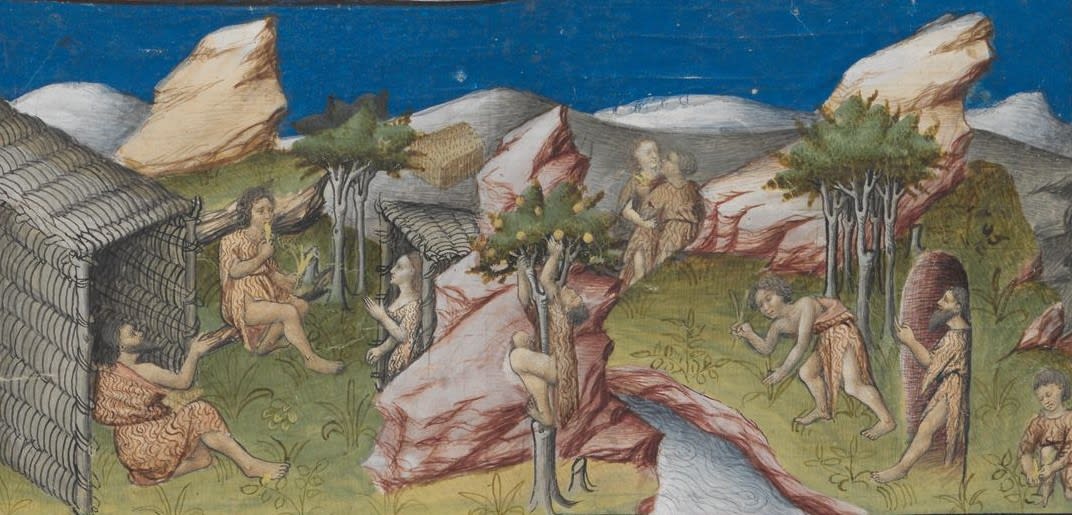
Introduction
Initially mistaken for a Flemish artist, the Master of the Vienna Roman de la Rose was named so in 1925 by Friedrich Winkler. It is only in 1993 that François Avril correctly recognized the illuminator as a French artist working in Lyon during the mid-15th century. Through recent studies and documentary evidence, the Master of the Vienna Roman de la Rose is now identified with Jean Hortart ("Janin l'enlumineur, dit d'Écosse"), who originates from Bourges and is documented in Lyon. The artist developed a distinctive style that evolved from a fine, meticulous brushwork to a more pointillist technique with softer modeling influenced by Flemish Primitives. Working in Lyon, in the middle of the Rhodanien current, the Master of the Vienna Roman de la Rose (Jean Hortart) is a perfect case for the fascinating study of artistic exchanges along the Rhône River and for the understanding of the reception of stylistic influences in cities from Avignon to Geneva. The present illuminated leaf depicting Saint Luke dates c. 1465 and originated from an identified Book of Hours from which only one other sister leaf is currently located. The miniature at hand perfectly exemplifies the artist's mature style, with its pointillist technique that recalls the formulas of Barthélemy d'Eyck.
We thank Dr. Mireia Castaño for her expertise.
Commentary
First identified in 1925 by art historian Friedrich Winkler (1888-1965) based on the manuscript that gives the artist his nickname, the magnificent copy of the Roman de la Rose held in Vienna (Österreichische Nationalbibliothek, cod. 2568, a manuscript that Gustave Waagen considered illuminated by an artist of Hubert van Eyck's generation), the illuminator was initially confused with a Flemish artist. He was subsequently compared to Jean Fouquet and then to Barthélemy d'Eyck, before being judiciously associated with artists active at the court of Amadeus VIII in Savoy. It was in 1993 that specialist François Avril definitively situated this artist's activity in Lyon and enriched his corpus with several works that allow for a clearer understanding of a unique personality active in a then little-known artistic center.
Master of the Vienna Roman de la Rose (Jean Horart), The Golden Age, c. 1430. Guillaume de Lorris & Jean de Meun, Roman de la Rose. Vienna, ÖNB, cod. 2568.
The Master of the Vienna Roman de la Rose developed a personal and recognizable style: in his youth, the illuminator is defined by a fine brushstroke and remarkable meticulousness of treatment that finds its best example in the Roman de la Rose copy. Having come into contact with the formulas of the Flemish Primitives, particularly Barthélemy d'Eyck, the Master of the Vienna Roman de la Rose's style evolved and is characterized, in his last phase of activity, by a more pointillist application and softer modeling. The Eyckian contribution to the Master of the Vienna Roman de la Rose's work is clearly perceptible, for example, in the beautiful figure he painted in the Collection of astrological texts (Paris, Bibliothèque nationale de France, ms. lat. 7321), while his softer, somewhat blurred brushwork, can be illustrated by the Collection of poetic texts preserved in Berlin (Kupferstichkabinett, ms. 78 C 7).
Recently studied by Mireia Castaño, who published the first monograph dedicated to the artist, the Master of the Vienna Roman de la Rose emerges as one of the rare and best representatives of illumination from the mid-15th century in Lyon. The artist's style is related to the influences that circulated through commercial exchanges, following the natural axis of the Rhône. This current originated from Avignon and traveled up the Rhône toward Lyon and Geneva. The formulas of artists active in Provence, including the famous Barthélemy d'Eyck, reached the city of Lyon, where the Master of the Vienna Roman de la Rose absorbed them. His style, in turn, influenced the city of Geneva and its surroundings, finding echoes among Savoyard artists like Jean Bapteur or the
Master of Foljambe. Thanks to the economic growth in Lyon around 1460, notably due to the important fairs held there, numerous patrons and artists traveled there; thus, the influence of Jean Fouquet and his followers can be found in the late works of the Master of the Vienna Roman de la Rose. It is therefore interesting to note that the Lyon illuminator painted two
Equestrian portraits in the
Armorial of Gilles le Bouvier, a manuscript in which Jean Fouquet later added one portrait (Paris, Bibliothèque nationale de France, ms. fr. 4985).

Master of the Vienna Roman de la Rose (Jean Hortart), Charles d'Anjou, c. 1448-1449. Gilles le Bouvier, Armorial. Paris, BnF, ms. fr. 4895.
Moreover, under the artistic personality of the Master of the Vienna Roman de la Rose most certainly lies the historical figure of Jean Hortart ("Janin l'enlumineur, dit d'Écosse"), who was paid in 1463 to illuminate the copy of the Book of King Modus and Queen Racio now in New York (Pierpont Morgan Library, ms. M. 820). To create this manuscript, Jean Hortart was assisted by Jean Juys ("Jehan de Juys"), an artist documented in Lyon between 1412 and 1465 who is, perhaps, the author of the Chess Players stained glass window preserved at the Cluny Museum in Paris. The preparatory drawing for this stained glass is sometimes attributed to the Master of the Vienna Roman de la Rose (Jean Hortart) himself, but Mireia Castaño rather suggests attributing to the master a set of nine stained glass windows (or the drawings) held in the Musée des Beaux-Arts de Dijon and in the Metropolitan Museum of Art in New York.

Jean Juys (?), Chess Players, c. 1455. Paris, Musée national du Moyen Âge, Cl. 23422.
Published in the artist's catalogue raisonné, the present illuminated leaf depicts Saint Luke and comes from an identified Book of Hours particularly interesting as it could be one of the only witnesses of the master's activity in Valence, and more broadly one of the rare traces of manuscripts production in Valence. Last appearing in 1990 at Sotheby's, the Book of Hours (already incomplete) contained fifteen illuminations. The Master of the Vienna Roman de la Rose (Jean Hortart) painted the three evangelists, while an anonymous artist from Lyon is responsible for painting the twelve other illuminations. Of all the sister leaves, only Saint Matthew is located: it was sold alongside the present Saint Luke in New York 2014 and most probably bought by the same collector. In 2018, the Saint Matthew was sold by the collector, along with a portion of his collection, to the University of North Texas.
The present Saint Luke shows all the stylistic characteristics that define the last years of activity of the Master of the Vienna Roman de la Rose (Jean Hortart): volumes are rendered through the accumulation of small dots and careful treatment of shadows and lights, which minutely model the saint's face. The quick brushstroke, the vaporous aspect and morphological characteristics of the present Saint Luke compare particularly well with the paintings the master created in two Books of Hours, both held in Paris (Bibliothèque nationale de France, ms. nouv. acq. lat. 3213, and ms. lat. 1353) and executed, like our miniature, around 1465.
With its vivid colors, its remarkable treatment of volumes, and its meticulous rendering of modeling, the miniature at hand is a charming example of the art of the Master of the Vienna Roman de la Rose, now identified with Jean Hortart. Important artist that sheds light on the manuscripts production in Lyon during the mid-15th century, Jean Hortart is also a unique representative of the Rhodanien current, the fascinating question of the exchanges of stylistic influences following the Rhône, from Geneva to Avignon.
Material description
One illuminated leaf on vellum, from a Book of Hours, in Latin.
Written in Bastarda, brown and pink ink; 17 lines, on one column.
Paintings: one large miniature depicting Saint Luke writing his Gospel in a church interior with columns and a blue honor cloth in the background, topped with a gold arch and framed by refined illuminated borders on all four sides (black rinceaux, gold ivy leaves, acanthus leaves in gold, red and blue, and other floral ornaments). The reverse shows an illuminated border on one side (black rinceaux, gold ivy leaves, floral ornaments), one 2-lines initial ('B') and one line-filler.
Text: extract from Gospel sequences (according to Saint Luke): "Sequentia sancti evangelii secundum Lucam"; "ut quod possibilitas nostra non obtinet, ejus nobis intercessione donetur" (on the reverse).
The present miniature is in very good condition. The parchment is clean, the colors have remained vivid, the handwriting is readable. We note usual signs of age (small dirt, some rubbing, ink slightly faded, minor pigments losses, one part with darker blue, between the green wig of the bull and the saint's body, may be repainted). On the reverse, usual signs of age as well as three modern inscriptions in graphite: "15" (top right, ex-foliation), "ST12833a" (bottom left, probably an old inventory number), and "$4000" (bottom right, old price). The miniature is housed in a modern wooden frame with anti-UV and anti-reflective glass protection.
Provenance
Part of a Book of Hours (part of the Gospels sequences, ex-fol. 15v) for the use of Valence realized in Lyon or Valence (France), c. 1465 by the Master of the Vienna Roman de la Rose (Jean Hortart) and an anonymous illuminator from Lyon, for an unknown patron.ess.
The first known owner of the Book of Hours was, during the 17th century, Jean-Baptiste Goudal of Toulouse (his name was inscribed, in a 17th century calligraphy, at the end of the manuscript).
England, property of the Richardson (armorial bookplate appeared on the manuscript) family. By descent, to the following:
Oxford, property of John Nowell Linton Myres (1902-1989), former librarian of the Bodleian Library of Oxford between 1947 and 1965 and President of the Society of Antiquaries from 1970 to 1975.
London, Sotheby's, June 19, 1990, lot 114, as "south-east France (perhaps Valence)". Bought by the following:
New York, H. P. Kraus' company (his widow Hanni Zucker and their daughter Mary Ann Folter).
Dismembered after the 1990 sale and before the following (the provenance of the present Saint Luke is as follows):
New York, Swann Galleries, December 14, 2014, part of lot 305.
McMinnville, Philip J. Pirages Fine Books and Manuscripts, 2019.
France, private collection.
Sister leaves
Ex-fol. 13v: Saint Matthew [by the Master of the Vienna Roman de la Rose (Jean Hortart)]: New York, Swann Galleries, December 14, 2014, part of lot 305; USA, private collection; Denton, University of North Texas, Special collections.
Ex-fol. 17v: Saint Mark [by the Master of the Vienna Roman de la Rose (Jean Hortart)]: present location unknown.
Ex-fol. 28v: Visitation [by an anonymous illuminator from Lyon]: present location unknown.
Ex-fol. 46: Massacre of the Innocents [by an anonymous illuminator from Lyon]: present location unknown.
Ex-fol. 51: Coronation of the Virgin [by an anonymous illuminator from Lyon]: present location unknown.
Ex-fol. 58v: King David [by an anonymous illuminator from Lyon]: present location unknown.
Ex-fol. 86v: Virgin and Child in a rose garden [by an anonymous illuminator from Lyon]: present location unknown.
Ex-fol. 91v: Saint Lawrence [by an anonymous illuminator from Lyon]: present location unknown.
Ex-fol. 92v: Saint Christopher [by an anonymous illuminator from Lyon]: present location unknown.
Ex-fol. 93v: Saint Blaise [by an anonymous illuminator from Lyon]: Munich, Hartung & Hartung Antiquariat, November 22, 2005, lot 131; present location unknown.
Ex-fol. 96v: Saint Anthony [by an anonymous illuminator from Lyon]: present location unknown.
Ex-fol. 97v: Peter of Luxembourg [by an anonymous illuminator from Lyon]: Munich, Hartung & Hartung Antiquariat, November 22, 2005, lot 130; present location unknown.
Ex-fol. 98v: Saint Mary Magdalene [by an anonymous illuminator from Lyon]: present location unknown.
Ex-fol. 99v: Saint Barbara [by an anonymous illuminator from Lyon]: Munich, Hartung & Hartung Antiquariat, November 22, 2005, lot 129; present location unknown.
The present Saint Luke is published in
M. Castaño, Le Maître du Roman de la Rose de Vienne, Cinisello Balsamo, 2019, p. 103, 111 (n. 74), 153-154, cat. n° 30, ill. b./w.
M. Castaño, "Le Lyonnais", in: Peindre en France: trente ans de recherche sur les manuscrits à peintures en France, 1440-1520, dir. F. Elsig, D. Vanwijnsberghe & S. Gras (forthcoming).
Further readings on the illuminator
F. Waagen, Die Vornehmsten Kunstdenkmäler in Wien, Vienna, 1866.R. Beer, "Les principaux manuscrits à peintures de la bibliothèque impériale de Vienne", Bulletin de la Société française de reproductions de manuscrits à peintures, 1912 (2).F. Winkler, Die Flämische Buchmalerei des XV. und XVI. Jahrhunderts: Künstler und Werke von den Brüdern van Eyck bis zu Simon Bening, Leipzig, 1925.P. Wescher, Beschreibendes Verzeichnis der Miniaturen -Handschriften und Einzelbätter- des Kupferstichkabinetts der Staatlichen Museen Berlin, Leipzig, 1931.E. Trenkler, "Les principaux manuscrits à peintures de la bibliothèque impériale de Vienne", Bulletin de la Société française de reproductions de manuscrits à peintures, 1938.K. Nordenfalk, Kung Praktiks och Drottning Teoris Jaktbok. Le livre de deduis du roi Modus et de la reine Ratio, Stockholm, 1955.L. M. J. Delaissé, Le Siècle d'Or de la miniature flamande: le mécénat de Philippe le Bon, Brussels, 1959.Europäische Kunst um 1400, exhibition catalogue (Vienne, Kunsthistorischesmuseum, May 7-July 31, 1962), ed. A. Schärf, Vienna, 1962.A. Griseri, "Nell'area di Jaquerio e di Bapteur", Paragone, 1963 (161).J. Plummer, The Last Flowering. French painting in manuscripts 1420-1530, New York & London, 1982.F. Avril & N. Reynaud, Les manuscrits à peintures en France, 1440-1520, Paris, 1993.F. Elsig, La peinture en France au XVe siècle, Cinisello Balsamo, 2004.F. Elsig, "Dossier Lyonnais", in: Quand la peinture était dans les livres. Mélanges en l'honneur de François Avril, ed. M. Hofmann & C. Zöhl, Turnhout, 2007.M. Castaño, "Le Maître du Roman de la Rose de Vienne et sa clientèle à Bourges", in: Peindre à Bourges aux XVe-XVIe siècles, dir. F. Elsig, Cinisello Balsamo, 2018.M. Castaño, "Le Maître de Gaste: enluminure et broderie à Lyon au XVe siècle", Bibliothèque d'Humanisme et Renaissance, 2019 (1).



